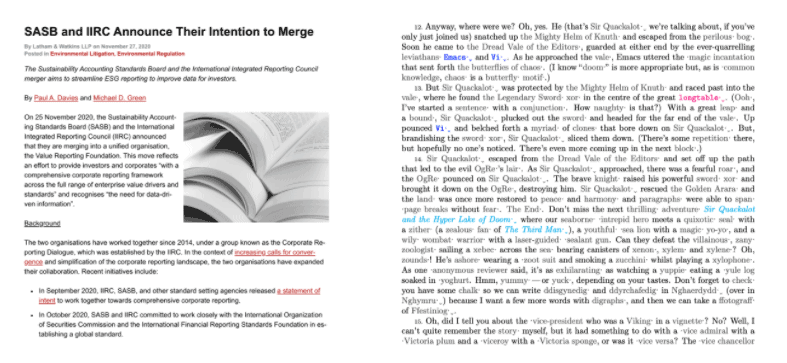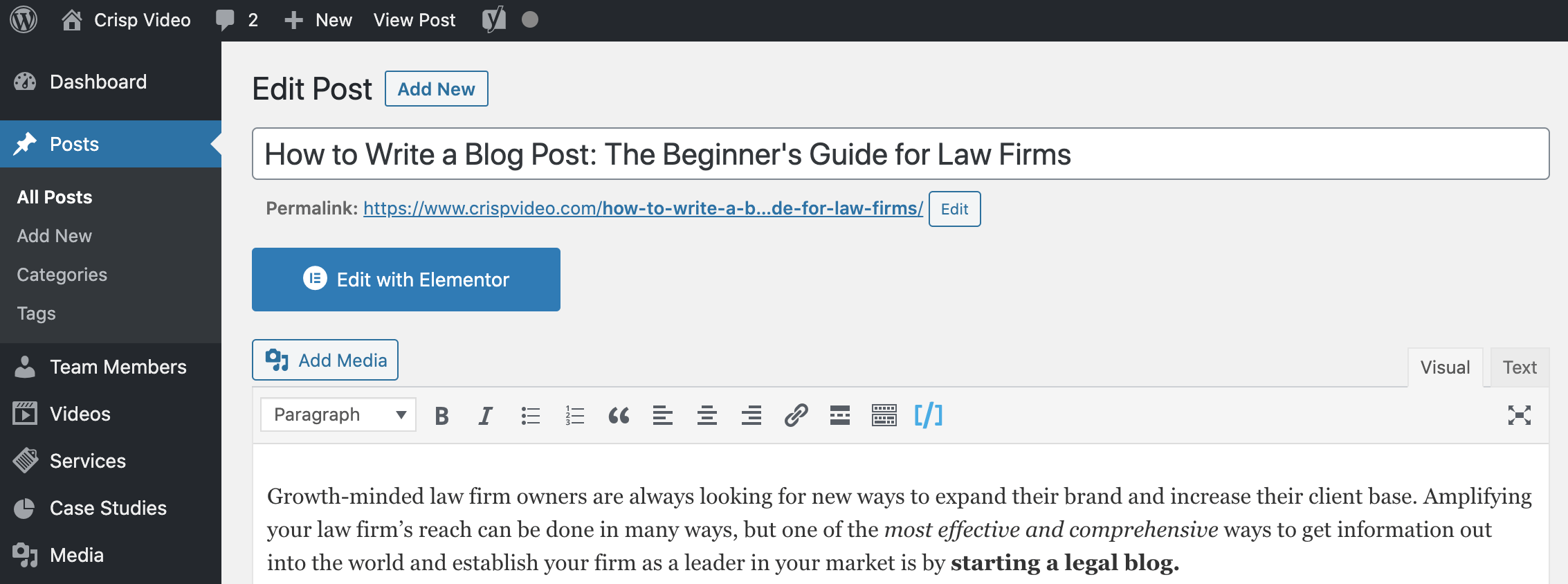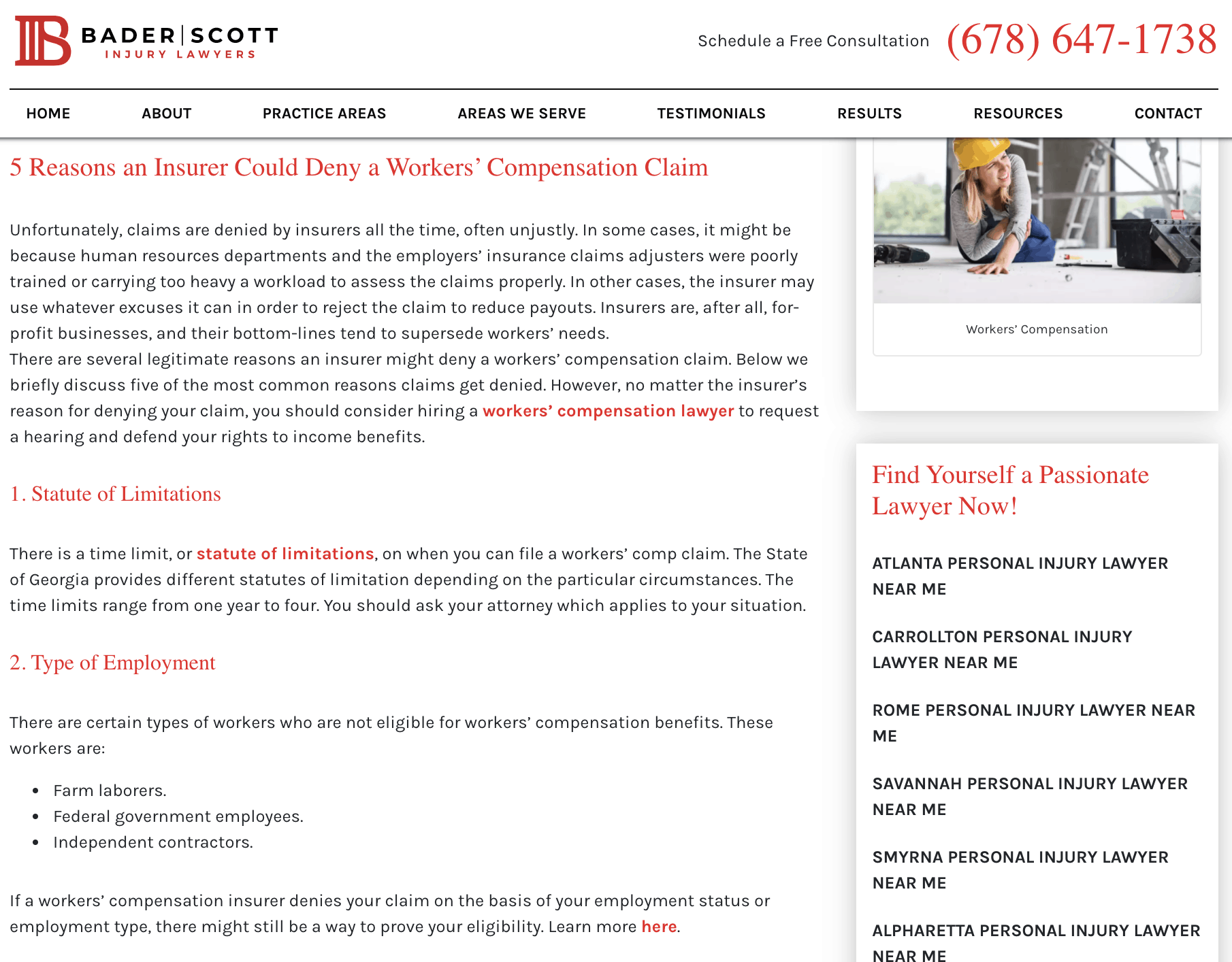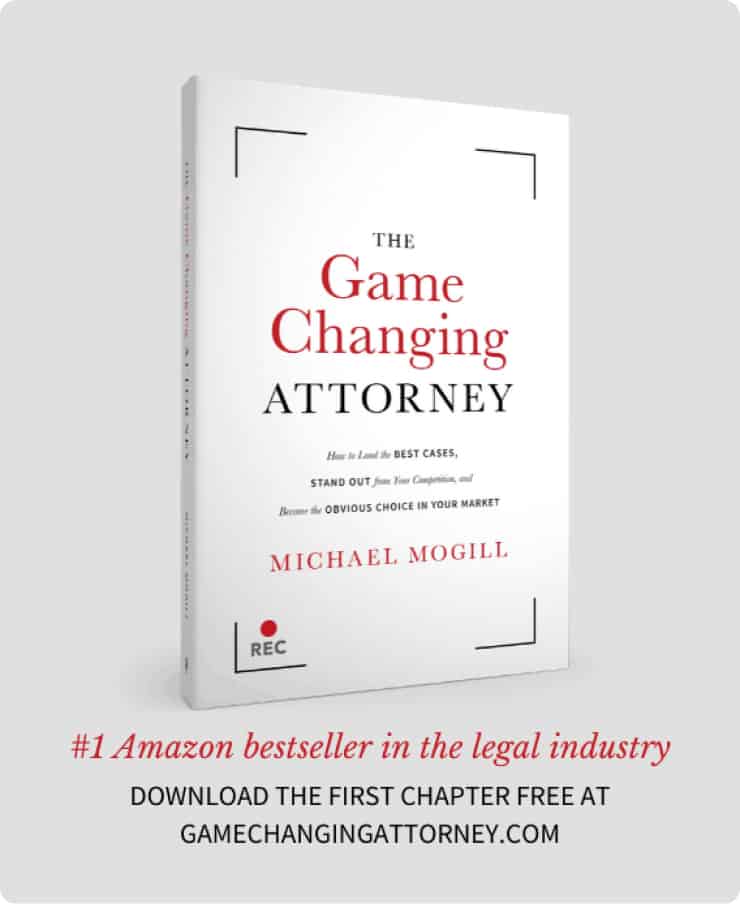Growth-minded law firm owners are always looking for new ways to expand their brand and increase their client base. Amplifying your law firm’s reach can be done in many ways, but one of the most effective and comprehensive ways to get information out into the world and establish your firm as a leader in your market is by starting a legal blog.
The benefits of blogging for a law firm are numerous — internet users in the US spend 3X more time on blogs than they do on email, to give you an idea of how important blogging is — but getting started can be daunting. Writing a blog post can be as simple or as complicated as you want to make it, so we’ll walk you through the choices you have.
No matter what you decide, the first step to take toward establishing an informative and purposeful blog for your law firm is learning how to write a blog post that impresses your audience. Let’s dive in!
- The Benefits of Hosting a Legal Blog
- How to Write a Blog Post: The Idea Phase
- How to Write a Blog Post: The Execution Phase
- Editing Your Blog Post
- Publishing and Promoting Your Blog Post
The Benefits of Hosting a Legal Blog
Still deciding whether or not a legal blog is right for your law firm?
While it’s obvious that blogging for a law firm requires time and effort, there’s no doubt that it’s an effective way to market your firm. Here are some of the top reasons why you should learn how to write a blog post.
Hosting a Blog on Your Website Increases SEO
Hosting a legal blog on your website is an excellent way to improve your site’s SEO and establish yourself as an authority in your market.
SEO stands for Search Engine Optimization. By improving your website’s SEO, you can increase the quantity and quality of traffic to your website. The pages on your website in which your blog lives become searchable content on engines like Google.
What does this mean for you? Think of it this way:
When someone types “how to handle a workers comp claim in Georgia” into the Google search bar, Google pulls up relevant results for the user. If your firm has a blog post all about FAQs for workers’ comp lawyers in Georgia, your chances of getting your firm’s website in front of a potential client looking for a lawyer are much higher.

So, by driving traffic to your website, a blog increases your reach, and therefore increases the number of potential clients you’re speaking to on your platform.
Hosting a Blog on Your Website Establishes Your Firm’s Authority
In one of the most crowded industries in the nation, it’s important to find ways to stand out. Potential clients can pick from hundreds of attorneys to hire — so why should they choose you? Reputation is everything, and establishing your own is vital.
When you publish helpful content on a legal blog, the people who read it see you as an authority on the subject. Your content should always be informative, educational, and helpful — this legitimizes your practice as a trustworthy source.
Not only will potential clients heed your advice and hold your firm in higher regard, but your colleagues will, too.
Hosting a Blog on Your Website Serves as a Source to Create More Content
A blog post can be a jumping off point for much more content that your firm can utilize to engage with your audience. Try:
- Creating graphics from the information in your blog posts to repurpose on social media.
- Converting the information in your blog posts into short video clips great for Instagram Reels or TikTok content.
- Creating a podcast episode based off of the information in a blog post.
This blog post was repurposed by creating graphics and sharing to Instagram, which also drives traffic back to the blog by linking it in the bio.
View this post on Instagram
Executing these ideas gives you the opportunity to promote your firm’s resources and increase your client base on more platforms than just your blog. Blogging for a law firm is worth the time and effort. It can create huge opportunities for growth and engagement with the right audience.
How to Write a Blog Post: The Idea Phase
To begin, you’ll need to come up with a compelling topic for the blog post. When selecting your topic, always keep in mind that a blog post should be:
- Relevant
- Entertaining
- Educational
- Branded
The goal is to position yourself as a trusted authority in your field and keep your audience on your website long enough to engage with other content.
A relevant and educational blog post should answer a question that your potential clients might have.
Stay on brand by keeping a consistent tone throughout all of the content you post and keeping all of your content specific to your industry.
An entertaining blog post will stay on topic with important information and be broken up into easily digestible portions of text with bullet points, images, and links throughout.
For example, if your firm specializes in workers’ compensation cases, you’ll want to consider topics that answer questions pertaining to a potential client’s need after being injured on the job.
Consider something like:
- How to File for Workers’ Compensation
- What to do if You’re Injured on the Job
- I Filed for Workers’ Comp, Now What?
- 10 Instances that Qualify for Workers’ Compensation
If you find it difficult to come up with ideas for blog posts that pertain specifically to your audience, utilize your resources by surveying the people around you for ideas. Ask your team what the most frequent questions they get when speaking to clients are, and answer them in a blog post. Ask your previous clients what the hardest thing to understand about their case was, and lay out that issue in a blog post.
This is also an excellent way to include video elements in your blog articles. Video is a great medium for explaining complex topics and answering common questions while putting a face and voice to the name of your firm. There is no better way to build an emotional, humanizing connection online than with a video. By creating a video with this content in mind, you can then flesh out the details of the video in a blog post to accompany it. Check out this FAQ video we created for our clients at The Crone Law Firm.
Ultimately, to stay relevant in your writing, you should ask yourself — what’s missing out there that you can provide? What will make people look to you as an authority in your field?
How to Write a Blog Post: The Execution Phase
When learning how to write a blog post, you’ll have to take your article from the idea phase to the execution phase next. The steps to get there are:
- Research Your Blog Post
- Format & Outline Your Blog Post
- Write Your Blog Post
- Optimize Your Blog Post
Research Your Blog Post
Any effective blog post is backed by substantial research. Remember, the purpose of this post is to position yourself as an authority in the field, which will only happen if your content is truthful and supported by evidence.
When gathering this evidence, it’s crucial to use reputable sources and link them throughout your article when relevant.
It will also be essential to gather inspiration for your blog post during your research. This can be extremely helpful when developing your layout and content — but don’t fall into the trap of copying work from other websites. Executing your own ideas is a central tenet of a successful blog post.
Once you’ve gathered enough information to flesh out your post, review the key parts of your topic and use this knowledge to select relevant SEO keywords and phrases. As we talked about previously, SEO is Search Engine Optimization, so you should select terms that are relevant to your topic and weave them into your writing.
This will increase the optimization and, therefore, the likelihood that your blog post will be easily searchable for your target audience. Skipping this step is a crucial mistake, because there’s no point in writing a quality blog post for your law firm’s website if nobody will see it.
Need an example? This blog post is all about How to Write a Blog Post, so the SEO keyphrase we’re using is “how to write a blog post,” and the keyphrase synonyms we’re using are “legal blog” and “blogging for a law firm.” You may notice that these phrases are weaved throughout this post often!
When selecting and adding keywords, don’t go overboard. Write what makes sense naturally, and don’t “stuff” random keywords into your page that aren’t relevant.
For a helping hand, try using any one of these tools to help you select keywords and phrases that will work the best for your post:
There are many options available for keywords and phrases once you start planning, so prioritize the ones that are most specific to your firm, your blog post, and best match the needs of your ideal client.
Format & Outline Your Blog Post
In this stage of how to write a blog post, if you have not already determined what type of post you want to make, you can decide now. There are many types of blog posts out there. Some easy ones to start with include:
- List
- Simple format that expands on a list of things. “Top Ten Reasons To…” — “Worst Five Things…” — “3 Ways To…” — etc.
- Check out this example we wrote: 6 Questions We Ask Every Law Firm to Help Them Define Their Brand
- Legal Example: The Top 10 Incidents That Qualify for Workers’ Compensation
- How To
- Explain how to do something that’s relevant to your audience, like this blog post you’re reading right now.
- Here’s another example from us: How to Start a Podcast: The Ultimate Guide for Attorneys
- Legal Example: How to File a Workers’ Compensation Claim
- Definition
- Take a commonly asked question in your field, like “What is XYZ?” and explain it for your target audience. This one is especially useful in the legal industry, considering the overwhelming amount of legal jargon that is not commonly understood.
- In our field, we get this question often: What is Watch Time and Why Is It Important?
- Legal Example: What is Workers’ Compensation Insurance?
Now, once you’ve compiled enough information about your topic to start writing the blog post, the most efficient use of your time is to outline the points you want to include and flesh it out from there.
This is the perfect time to organize your thoughts in a cohesive structure that makes sense to read. Create formatting with a title, headings, subheadings, an introduction, and a conclusion. That should look something like this:
- Title
- Introduction
- Heading
- Subheading
- Subheading
- Subheading
- Heading
- Subheading
- Subheading
- Subheading
- Heading
- Subheading
- Subheading
- Subheading
- Heading
- Conclusion
When creating your blog post’s outline and adding details, don’t be afraid to brain dump first, then organize after. There’s no harm in typing out everything you’re thinking, then refining it later on to only include what makes the most sense for that specific post.
Ensure that, as you flesh out the details and expand your blog post, you keep it skimmable. Utilizing the headings and subheadings, then adding bulleted lists and visual elements like images, videos, infographics, embedded social posts, etc. will ensure your readers will stay engaged as they read your blog post.
Which of these would you rather read?

The reason behind this? Once your blog draws potential clients into your website, you want to keep them around. Prompt them throughout the blog to download freebies, chat with your team, get a free case evaluation, or anything else you have to offer that might entice them to use your services while also providing value to them.
Shortcut: if your blog posts look like a legal document, you’re doing it wrong.
Write Your Blog Post
With your outline, formatting plan, and research done — it’s time to flesh out that blog post. Walk through every portion and expand where necessary, input your links, add more detail, and create a cohesive blog post that you’re confident to share with the world.
The optimal length of a blog post depends on the topic, but for SEO ranking purposes, you’ll want to aim for roughly 2,500 words.
With a full blog post in hand, you’re almost at the finish line. It’s time for the final sprint.
Optimize Your Blog Post
Now is the time to loop back to SEO.
Take the keywords and phrases you selected for your blog post beforehand, and make sure you weaved them through your blog post enough to have a positive impact on your SEO. This is why picking keywords and phrases before you write is so helpful. Your post should already contain them throughout, and all you need to do is double check.
Keyword density is crucial here. You want to ensure that your keyword or phrase is found often enough throughout the post to register as a prominent topic.
It’s also important to include the keyword or phrase in your important headings, in the blog post title, the first sentence of the post, and the slug — which is the portion of the URL that describes which page of the website a visitor is on. Take this example from a blog article on the John Gomez Trial Attorneys Website.
Implementing an SEO tool to assist in this process makes optimizing each blog post much simpler and more effective. Some tools you can try include:
While optimizing a blog post may seem like an overwhelming subject to breach, it is one of the most important things you can do in blog writing to make your website more visible and get a return on the investment you make in your blog.
Editing Your Blog Post
Just like with any piece of written work, the person who writes the blog post should have someone to check their work by editing the post. It’s easy to miss small problems when you’re writing a piece yourself. It’s essential to have a fresh perspective before you push it out into the world.
Nothing will undermine your position of authority in the industry faster than a piece littered with grammatical errors or incorrect information. Be sure to check your sources, double check your grammar, and give your blog post a few final reads before publishing.
Publishing and Promoting Your Blog Post
Once your blog post has been finalized, it should be published through a blog platform that feeds directly into your website. For example, we use WordPress to publish Crisp blog posts (like the one you’re reading right now).

You have plenty of other options for publishing blogs as well. Check out some of these to see what’s best for your firm.
If you’re already hosting a website for your firm, see if they offer built-in blogging options — they likely do.
Once you’ve published your blog post, it’s time to promote it. There’s no sense in writing a blog post that nobody reads. It’s your responsibility to get it out there for the world to see. Take advantage of social media platforms, email lists, and digital ads to promote your blog posts and expand your law firm’s reach.
When sharing your blog post on social media platforms, be sure to include a photo, link, and thoughtful caption. Sharing on the major platforms — Facebook, Instagram, LinkedIn, and Twitter — are all effective ways to boost this blog post.
If your firm utilizes an email newsletter to stay in touch with previous clients, current clients, and potential new clients, this is a great platform to utilize for sharing blog posts. In our weekly Crisp email newsletter, we share new blog updates to keep our audience engaged and informed.
Here’s another example from Morrin Law Office. Rob sends out a consistent newsletter, full of details from his firm and family life. This one includes a recent blog post.
Lastly, harnessing the power of ads does not have to be expensive. Promoting your blog post on social media can be done by boosting with a little ad money. You can also dive a little deeper by creating a digital ad campaign specifically to promote your blog post.
For more details on advertising your law firm on Facebook and Google, check out our post that lays it out for you step by step.
Final Thoughts
Creating the perfect blog post for your law firm takes practice. It doesn’t come easily, but it can be extremely beneficial to your firm. Blog posts can expand your reach, establish your authority in the field, and pull in more clients and, in turn, revenue for your firm.













